15 Beautiful Flax Flowers showcase nature’s exquisite palette, each variety adding its unique charm to landscapes. From the vibrant Scarlet Flax to the delicate Forget-Me-Nots, these flowers grace gardens with diverse hues and intricate petal designs.
Explore the elegance of Baby Blue Eyes, the hardiness of Alpine Flax, and the captivating allure of Golden Flax. Each flax species, with its distinct features, contributes to the kaleidoscope of colors that transforms gardens into stunning displays of natural artistry.
Let’s delve into the enchanting world of these 15 beautiful flax flowers, each a testament to the wonders of floral diversity.
Different Types of Flax Flowers
Prairie Flax (Linum Lewisii)
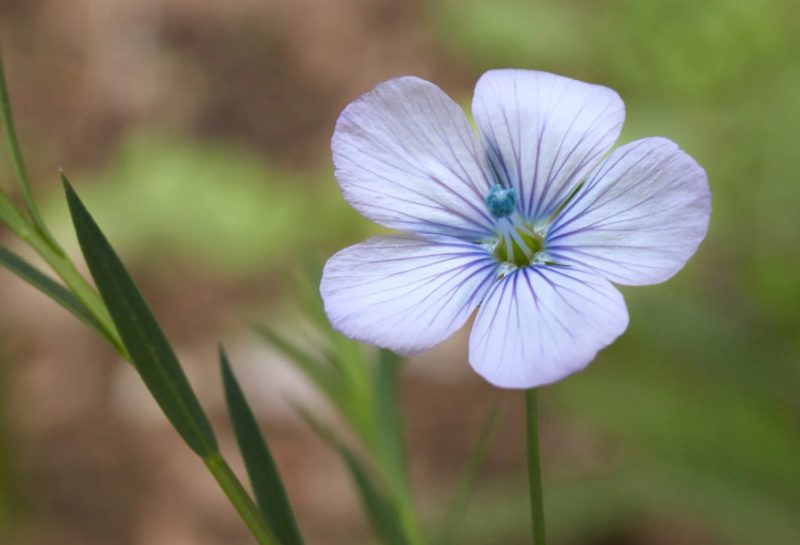
Native to North America, prairie flax is also known as Lewis flax, after its discoverer, Meriwether Lewis. It is mostly found in the western parts of the country. It is perfect for rock gardens because it is hardy and versatile, growing in ridges and dry slopes alike.
Prairie Flax has thin, bending stalks that can grow up to 80 cm in height. These stalks add a lovely finishing touch to borders. The delicate dark blue lines and pale blue petals with a yellow center adorn the flowers, which give the surrounding scenery a refined appearance.
Alpine Flax (Linum Alpinum)
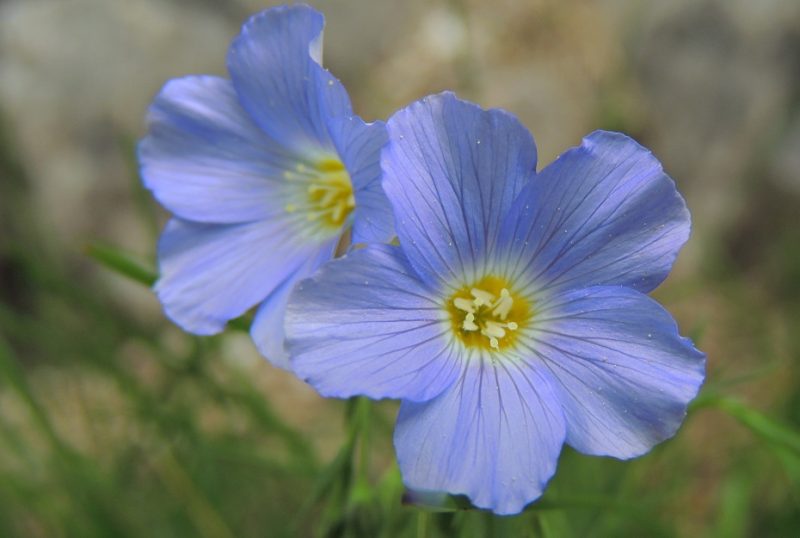
Because of its compact character, Alpine Flax (Linum Alpinum) is highly valued. Its woody base resembles a bushy mound, and it is frequently used to fill borders or rock gardens. It has five-petaled flowers that have a very pale blue color with thin dark blue lines adorning them. Its color is subtle in comparison to other vivid varieties of flax.
Alpine flax, which blooms from late spring to late summer, is known for its hardiness—it can withstand drought, deer, and rabbits. It also draws in a variety of pollinators, such as wasps, butterflies, and bees, which increases its ecological value to the garden.
Golden Flax (Linum Flavum)
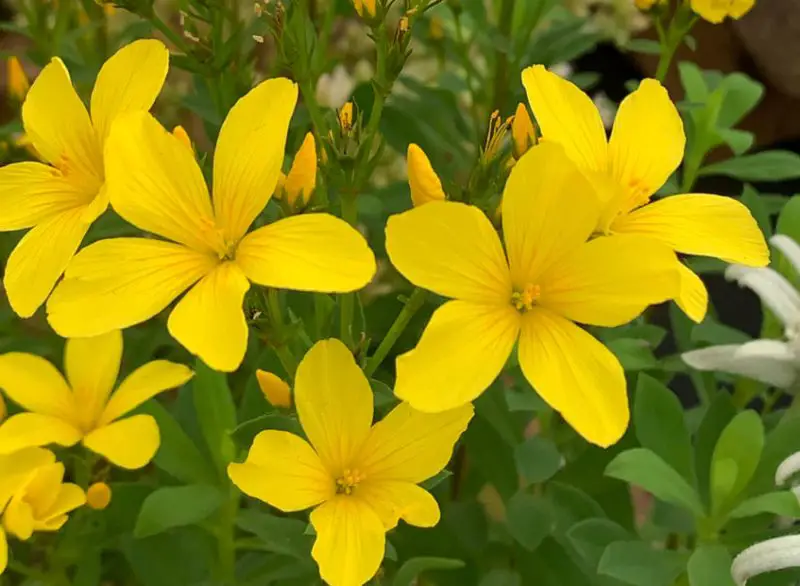
Yellow flax, or golden flax, is a compact perennial that is native to central and southern Europe. It can grow up to 12 inches tall and 8 inches wide. A great option for flower gardens or hanging baskets, the woody structure and dark green foliage give a striking contrast to the bright yellow flax flowers.
The golden flax thrives in full sun, highlighting its vibrant color, and works well in rock gardens or alpine gardens due to its propensity for dry soils.
Scarlet Flax (Linum Grandiflorum)
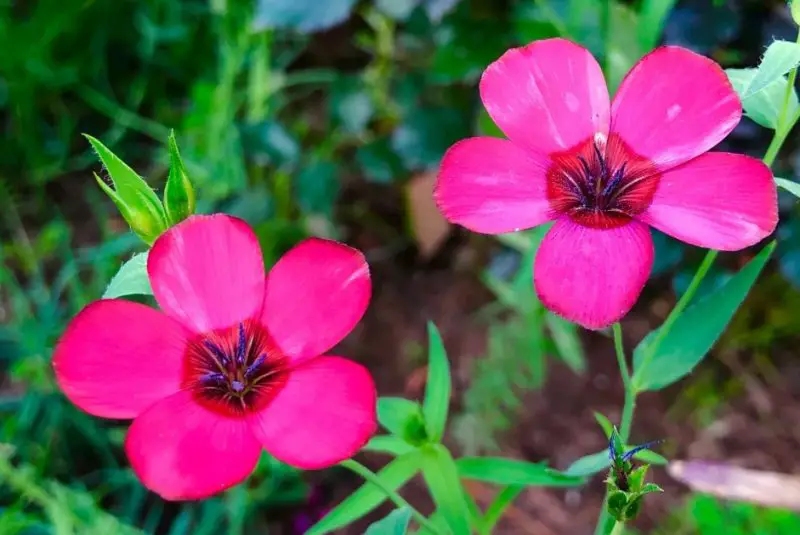
Originally from Algeria, scarlet flax, often called red or crimson flax, has spread to portions of Europe, Northern Africa, and North America. This annual herbaceous plant features five-petaled, vivid red flowers atop upright stalks with lance-shaped leaves. These bright blossoms, which have darkish cores resembling poppies, provide an amazing display.
Like its predecessors, scarlet flax is resilient and adaptable, and it grows best in dry, chalky, or sandy soil that drains well. Its magnificent blooms adorn the scenery all summer long and into the first few days of autumn.
Linum Perenne
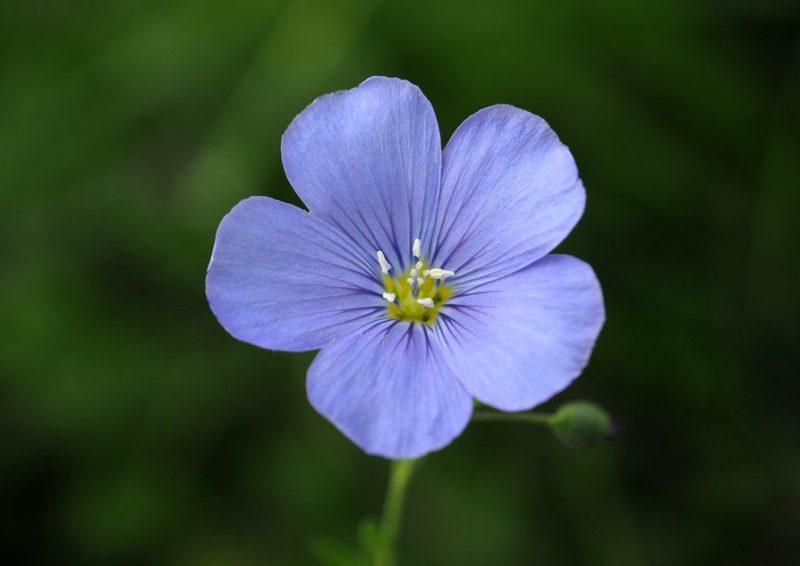
Linum perenne, sometimes called lint or blue flax, is a perennial flower native to Europe that is especially common in English gardens. It was brought to North America and thrives on mountain ranges and woods. It has pale blue flowers with five circular petals and a golden center on single stems that can grow up to 90 centimeters tall. Its cooked seeds are safe to consume, but the uncooked ones are poisonous.
Linum perenne is a multipurpose plant with both functional and decorative use. It is prized for the strong fibers in its stem and the health advantages of its roots.
Appar Blue Flax (Linum Perenne Appar)
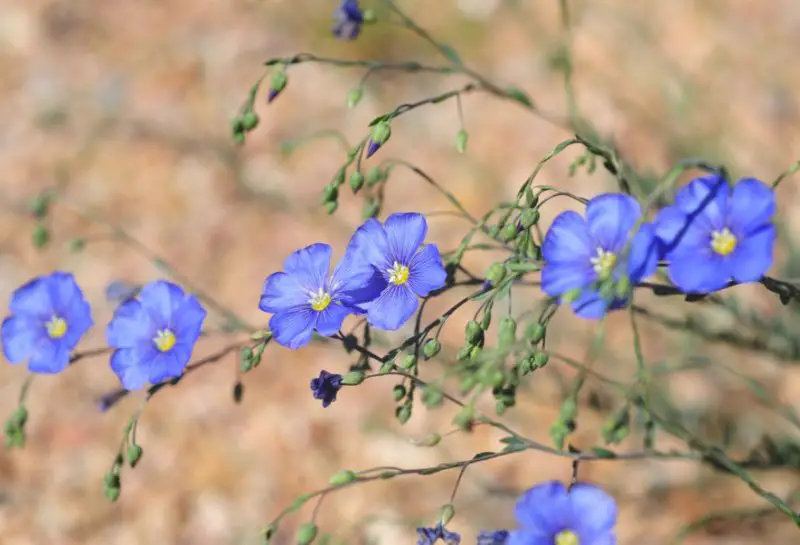
A dwarf cultivar of Linum Perenne, Appar Blue Flax is prized for its tiny, bright blue flowers. While maintaining the original’s structure, these flowers have a truer blue color. In addition to being aesthetically pleasing, these flowers are quite easy to grow, even in poor soil and dry environments. They are very low care because dead flower heads fall off spontaneously when they are ripe, making gardening easier.
Sapphire Blue Flax (Linum Perenne Sapphire)

The second type of Linum Perenne, Sapphire Blue Flax, has bright blooms that last from early spring to fall, making the garden alive for several months. It is not dwarf-sized, but it is nevertheless rather attractive with its blue blossoms, standing at a modest 12 to 15 inches. These flowers are hardy and easily grown; they are resistant to drought, deer, and rabbits, and they grow well over North America.
Sapphire Blue Flax is a low-maintenance yet eye-catching addition to any garden, growing readily in sandy soil.
Linum Narbonense

Native to Europe, Linum Narbonense is also referred to as blue flax or perennial flax. A pale blue flower with five spherical petals may be found on each stalk, which is between one and one and a half feet tall and wide. These flamboyant and gaudy blooms give gardens a whimsical feel.
Linum Narbonense, which has whorl-shaped grayish-green leaves, is a great choice for rock gardens and borders because it grows best in full sun and well-drained soil. A contented Linum Narbonense easily seeds itself, demonstrating its satisfaction in its surroundings.
Blossoms Resembling Flax Flowers
Periwinkles
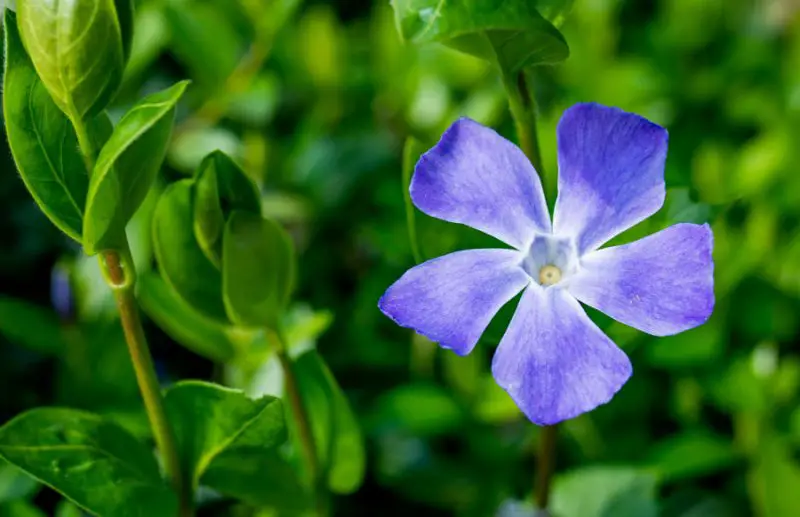
With their five-petaled petals, periwinkles frequently resemble flax flowers, thus choosing the right type is important for a match. Vinca major, or greater periwinkles, closely resembles blue flax blossoms, while red variations resemble scarlet flax flowers. These are easy-to-grow flowers that could become invasive if left unchecked because of their quick development. Periwinkles are still a beautiful addition to garden settings, adding beauty to hanging baskets or flower beds.
Stiff Blue-Eyed Grass (Sisyrinchium)
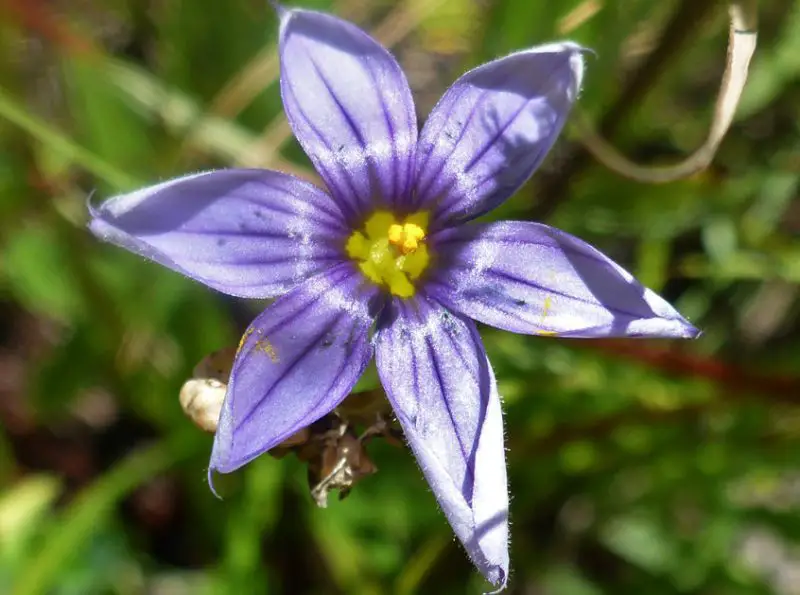
Despite the name, Stiff Blue-Eyed Grass (Sisyrinchium) is not a grass but a genus of tall flowers native to the New World. With soft blue petals and a yellow center, they resemble blue flax flowers. These flowers are easily grown and maintained, adapting well to diverse soils and environments.
Thriving in full sunlight and well-drained soil, stiff blue-eyed grasses present a charming option for gardeners seeking a delicate and vibrant addition to their landscapes.
Violets (Viola)
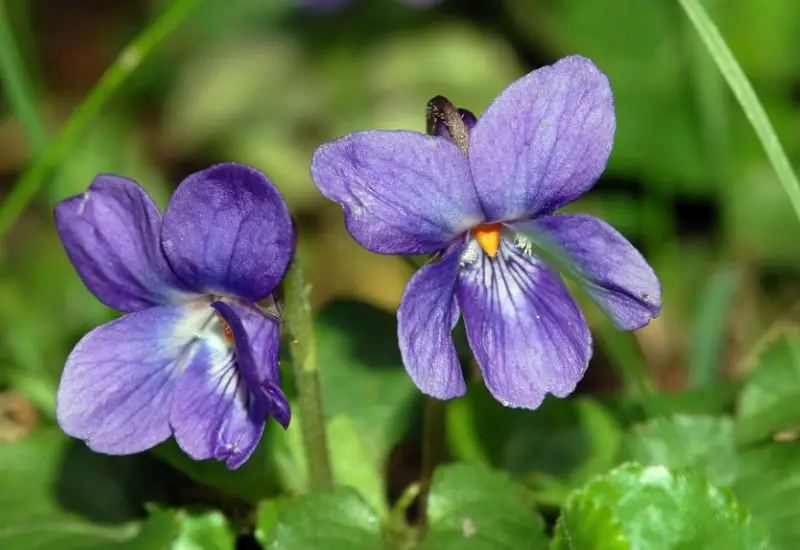
Because of their delicate beauty, violets (Viola) are frequently used in salads due to their edible nature. They are also well appreciated in gardens and floral arrangements. They have round petals and resemble blue flax flowers, which have a golden core and a violet-blue, round bloom.
Violets are resilient plants, however they are not like flax flowers in that they prefer damp, well-drained soil to dry ones. With their ageless elegance, violets are a delightful and adaptable addition to gardens that may be planted all year round.
Forget-Me-Nots (Myosotis)
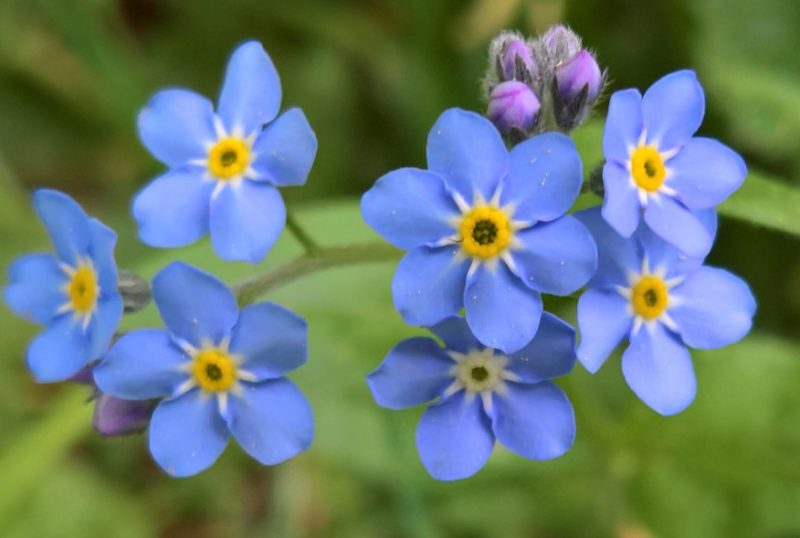
Forget-Me-Nots, belonging to the genus Myosotis, are renowned for their common bright blue, five-petaled flowers resembling blue flax blooms, notably with a yellow center. Serving as a harbinger of spring, they bloom earlier than flax flowers. Forget-me-nots are rapid growers, sometimes considered invasive, leading to their cultivation in flower pots.
Similar to blue flax flowers, they are remarkably easy to grow and maintain, making them a popular choice for both gardeners and admirers of vibrant spring blooms.
Baby Blue Eyes (Nemophila Menziesii)
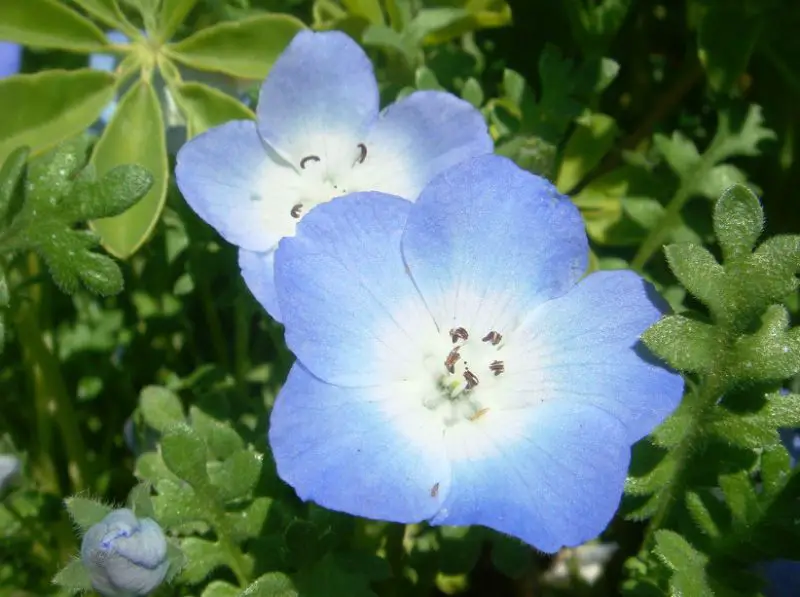
Originating from western North America, Baby Blue Eyes (Nemophila Menziesii) is a cherished annual herb admired for its delicate, bright, and light blue flowers. Resonating with the color and five-petaled structure akin to blue flax flowers, baby blue eyes stand out with a white center.
These flowers are effortlessly grown and maintained, thriving in partial shade during the heat of summer to prevent petal burn. Hardy and resilient to drought, baby blue eyes contribute a charming and resilient presence to gardens, adding a touch of elegance with their distinctive blue hues.






